|
|
|
| My Favourite Planet > English > Middle East > Turkey > Pergamon > gallery 2 |
| Pergamon gallery 2 |
Pergamon art |
 |
 |
8 of 26 |
 |
 |
|
| |
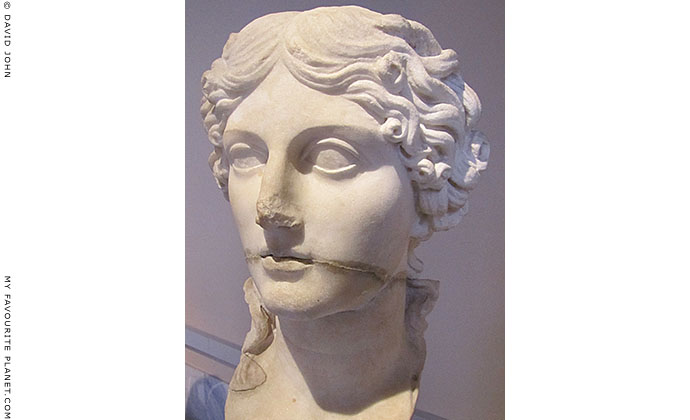
Agrippina the Elder. Marble head from Pergamon,
now in the Istanbul Archaeological Museum. |
| |
This bust of Agrippina the Elder, discovered at Pergamon [1], was made in the first half of the 1st century AD, perhaps on the orders of her son Emperor Caligula, after her death in exile from Rome in 33 AD. She is portrayed as a beautiful young woman with the kind of careless coiffure favoured by Pergamese sculptors.
Vipsania Agrippina, commonly known as Agrippina Major or Agrippina the Elder (14 BC - 33 AD), is thought to have been born in Athens during the visit of her parents Marcus Vipsanius Agrippa and Julia the Elder to the city.
She was an important member of Rome's first imperial family. To say that she was well-connected would be a gross understatement: she was closely related to the first four emperors and many of the major players in Roman politics at the end of the first century BC and the beginning of the first century AD, the period when Roman Republic became an empire and the greatest power in the world.
Here are some of Agrippina's relationships.
She was the:
• granddaughter of the Emperor Augustus;
• second daughter and fourth child of Augustus’ only natural daughter Julia the Elder and his close ally Marcus Vipsanius Agrippa;
• stepdaughter, sister-in-law and daughter-in-law of the Emperor Tiberius;
• wife of the politician and general Germanicus (Germanicus Julius Caesar, 15 BC - 19 AD, grandson of Marc Antony, great nephew of Augustus and adopted son and heir of Tiberius);
• maternal second cousin and sister-in-law of the Emperor Claudius;
• mother of Emperor Caligula (born Gaius Julius Caesar Germanicus), as well as Nero Caesar, Drusus Caesar, Julia Agrippina (Agrippina the Younger, mother of Emperor Nero; later married her uncle Emperor Claudius, 49 AD), Julia Drusilla and Julia Livilla;
• maternal grandmother of Emperor Nero.
The relationships of this family web were made even more complicated by marriages of cousins, remarriages and official adoptions.
Agrippina was the first woman of high rank in the Roman Empire to travel with her husband on military campaigns.
She was actively involved in politics, causing the enmity of Augustus and Tiberius. In 29 AD Tiberius tried her for treason and banished her to the island of Pandataria (today Ventotene) in the Tyrrhenian Sea, where Augustus had banished her mother for adultery in 2 BC. Agrippina died on the island in 33 AD.
After the death of Tiberius in 37 AD, Agrippina's son Caligula became emperor. He personally brought his mother's ashes to Rome, had the documents of her treason trial publicly burnt, dedicated the annual Circus Games as a day to honour her and issued coins in her memory (see photos below). The ashes were interred in her tomb in the Mausoleum of Augustus; the tombstone is now in the Capitoline Museums, Rome. |
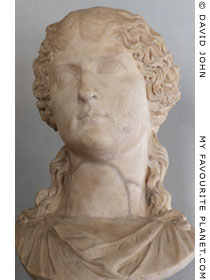
Bust of Agrippina the Elder
in Rome, 10-20 AD.
Capitoline Museums, Rome.
Inv. No. MC421.
Albani Collection. |
| |
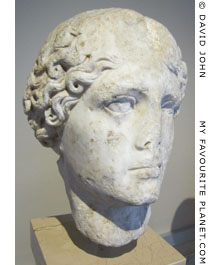
Marble head of Agrippina from
Ortahisa-Trapezus (Trabzon).
First half of 1st century AD.
Istanbul Archaeological
Museum. Inv. No. 4503 T. |
| |
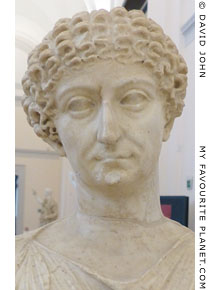
Head of the so-called "Agrippina Maggiore" statue. It is now
doubted that this is a portrait
of Agrippina. The head was
attached to the body of a
Roman copy of a 5th century
BC Greek statue of seated
Aphrodite by the circle of
Pheidias. Neronian-Flavian
period (2nd half of the 1st
century AD).
National Archaeological
Museum, Naples, Italy.
Inv. No. 6029.
Farnese Collection. |
| |
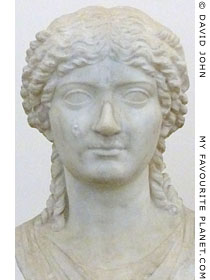
Another bust thought to be a
portrait of Agrippina the Elder,
or another Julio-Claudian
princess. 37-41 AD.
National Archaeological
Museum, Naples, Italy.
Inv. No. 6190.
Farnese Collection. |
| |
| |
 |
|
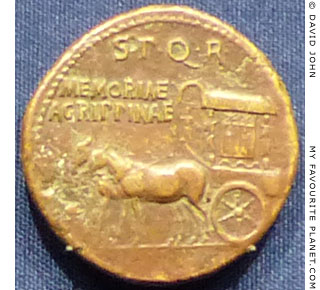 |
A bronze sestertius issued in Rome 37-41 AD by Caligula in memory of his mother Agrippina the Elder.
Left: Obverse, showing a draped bust of Agrippina facing right.
Inscription: AGRIPPINA M F GERMANICI CAESARIS
Image source: Guglielmo Ferrero, The women of the Caesars, translated by Christian Gauss.
Loring and Mussey, New York, 1911. (There appear to be several editions by different publishers.)
Coin "from the collection of Professor G. N. Olcott". George N. Olcott (1869-1912) was a Latin professor
at Columbia University who collected antiquities, particularly coins and inscriptions, for use as
teaching aids. His collection of coins and squeezes is now on display at Columbia University Library.
Right: Reverse, showing Agrippina's carpentum, a two-wheeled carriage with an arched
covering supported by a caryatid at each of the four corners, and drawn by two mules.
The carriage was paraded in the procession of the games Caligula instituted in her honour.
Inscription: SPQR MEMORIAE AGRIPPINAE
Münzkabinett, Staatliche Kunstsammlungen, Dresden.
These coins varied in size and weight, but are generally 34 mm in diameter,
and weigh around 24-32 grams. Although rare, several museums own examples,
and a small number have sold at auction in recent years. |
|
| |
Pergamon
gallery 2 |
Notes, references and links |
 |
|
1. Bust of Agrippina the Elder from Pergamon
Marble. Roman Imperial period, first half of the 1st century AD.
Found at the Sanctuary of Demeter, Pergamon, in 1909.
Height 40 cm.
Istanbul Archaeological Museum.
Inv. No. 2164 T (Cat. Mendel 557).
See:
H. Hepding, Athenische Mitteilungen, XXXV, 1910, pages 501-50; plate XXVI, 2.
Gustave Mendel (1873-1938), Catalogue des sculptures grecques, romaines et byzantines,
Tome Second, page 281. Musée Impérial, Constantinople (Istanbul), 1914. |
|
|
Maps, photos and articles: © David John,
except where otherwise specified.
Additional photos: © Konstanze Gundudis
All photos and articles are copyright protected.
Images and materials by other authors
have been attributed where applicable.
Please do not use these photos or articles without permission.
If you are interested in using any of the photos for your website,
project or publication, please get in contact.
Higher resolution versions are available on request. |
| |
 |
Visit the My Favourite Planet Group on Facebook.
Join the group, write a message or comment,
post photos and videos, start a discussion... |
|
|
| |
|
|
|